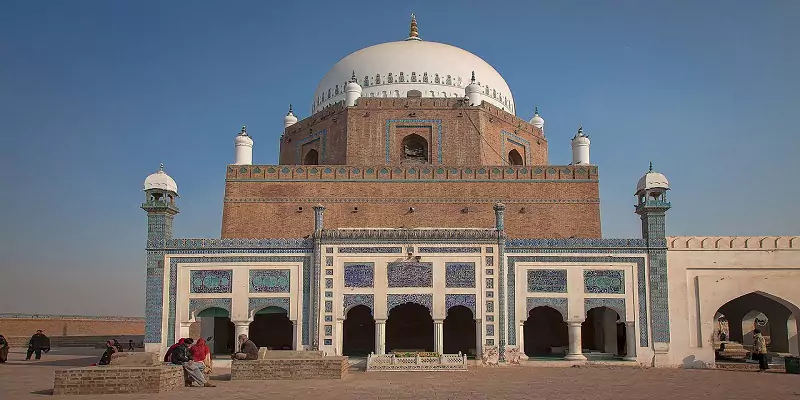Bahauddin Zakariya
The Tomb of Bahauddin Zakariya, situated in the ancient city of Multan, Pakistan, stands as a revered symbol of Sufi spirituality and cultural heritage. Dedicated to the prominent Sufi saint Bahauddin Zakariya, the mausoleum is a testament to the profound influence of Sufism in the region and serves as a spiritual sanctuary for devotees and visitors alike. With its intricate architecture, historical significance, and spiritual resonance, the Tomb of Bahauddin Zakariya encapsulates the rich tapestry of Multan's cultural and religious identity.
The history of the Tomb of Bahauddin Zakariya is intertwined with the life and teachings of the saint himself. Bahauddin Zakariya, born in 1170, was a leading Sufi saint and scholar who played a pivotal role in spreading Islamic teachings and Sufi mysticism in the Indian subcontinent. He was a prominent disciple of the famous Sufi saint Khawaja Qutbuddin Bakhtiar Kaki and later became a revered spiritual leader in his own right.
After Bahauddin Zakariya's passing in 1267, his disciples and followers sought to honor his memory by constructing a mausoleum. The mausoleum's construction began in the 13th century during the Tughluq dynasty and continued over the centuries, with subsequent rulers and patrons contributing to its expansion and embellishment. The final structure, as it stands today, is a culmination of various architectural influences, reflecting the evolving styles of different eras.
Approaching the Tomb of Bahauddin Zakariya, visitors are greeted by an imposing yet intricately adorned structure that serves as a testament to the architectural prowess of its time. The mausoleum features a distinctive blend of Islamic, Persian, and Indian architectural elements, creating a unique and harmonious design. The exterior is characterized by intricate tilework, calligraphy, and geometric patterns, showcasing the artistic achievements of the craftsmen who dedicated their skills to this sacred site.
The main entrance to the mausoleum is a majestic gateway adorned with ornate tile mosaic, Quranic inscriptions, and geometric designs. Passing through this grand entrance, visitors enter a vast courtyard surrounded by arched galleries, providing a sense of serenity and reverence. The courtyard serves as a communal space where devotees gather for prayers, reflection, and the recitation of Sufi poetry.
The central chamber of the Tomb of Bahauddin Zakariya houses the exquisite cenotaph marking the final resting place of the saint. The cenotaph is a masterpiece of Islamic artistry, featuring delicate carvings, intricate calligraphy, and floral patterns. The central dome, adorned with geometric designs and Quranic verses, symbolizes spiritual transcendence, creating an atmosphere of profound devotion within the chamber.
Adjacent to the central chamber, there is a mosque where congregational prayers are held. The mosque's architecture mirrors the motifs found in the mausoleum, creating a seamless integration of spiritual spaces within the complex. The mosque serves as a place of worship and contemplation, embodying the Sufi principles of humility, tolerance, and inclusivity.
The Tomb of Bahauddin Zakariya is not merely a historical monument; it is a living spiritual center that continues to attract devotees, pilgrims, and seekers of spiritual solace. The saint's tomb is considered a place of blessings, and visitors come to seek guidance, blessings, and the intercession of the revered Sufi saint. The atmosphere within the mausoleum is charged with a sense of devotion, as visitors engage in prayers, offer tributes, and connect with the spiritual energy that permeates the surroundings.
Throughout the year, the mausoleum becomes a focal point for Sufi gatherings and celebrations. Qawwali, a devotional form of music, resonates through the air during special occasions and annual Urs celebrations, marking the saint's death anniversary. Devotees, musicians, and visitors alike come together to partake in the spiritually charged atmosphere, fostering a sense of unity and shared reverence.
The Tomb of Bahauddin Zakariya holds profound cultural and social significance in the city of Multan. It serves as a symbol of communal harmony, bringing together people from diverse backgrounds and beliefs. The mausoleum complex is a melting pot of traditions, where devotees, regardless of their socio-economic status, ethnicity, or religious affiliations, come together to seek spiritual solace and celebrate the teachings of the revered saint.
The influence of the Tomb of Bahauddin Zakariya extends beyond the confines of its physical structure. It has inspired poets, writers, and artists who have paid homage to the saint and his teachings through their creative works. The mausoleum's cultural impact is evident in the myriad ways it has become interwoven with the city's identity, influencing art, literature, and the collective consciousness of Multan.
Over the centuries, the Tomb of Bahauddin Zakariya has faced challenges, including natural disasters and periods of political instability. However, the mausoleum has endured, thanks to the unwavering devotion of its followers and the ongoing efforts of custodians to preserve its sanctity. Restoration projects have been undertaken to safeguard the architectural integrity of the complex, ensuring that future generations can continue to experience the spiritual and cultural richness it embodies.
In the contemporary era, the Tomb of Bahauddin Zakariya continues to be a symbol of Multan's spiritual ethos. The mausoleum attracts a diverse array of visitors, from local devotees to international tourists seeking to immerse themselves in the city's spiritual and cultural heritage. The mausoleum's inclusive atmosphere, welcoming all who seek solace and inspiration, underscores its universal appeal.
The Tomb of Bahauddin Zakariya in Multan is not merely a historical monument; it is a spiritual sanctuary that transcends time and cultural boundaries. Its architectural splendor, vibrant traditions, and the spiritual legacy of the revered saint make it a beacon of Sufi mysticism. As devotees gather in prayer, musicians resonate with qawwali melodies, and the fragrance of incense fills the air, the Tomb of Bahauddin Zakariya stands as a testament to the enduring power of spirituality and communal harmony in the heart of Multan.

